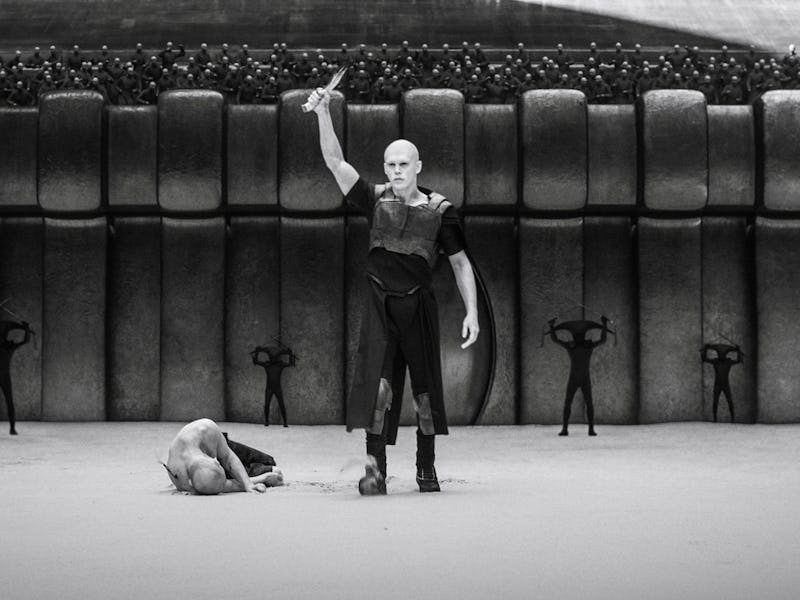Why Dune 2’s Thrilling Gladiator Fight Had to Be in Black-and-White
Denis Villeneuve and Greig Fraser reveal why Giedi Prime’s monochromatic look was more than just an aesthetic choice.

Compared to many other sci-fi blockbusters, there’s not much about Dune that’s black-and-white. The end of Dune: Part Two proves that its protagonist, Paul Atreides, is no hero, and that his holy war will reap nothing but galaxy-wide devastation. But in this morally ambiguous sci-fi saga, there’s one certainty: the Harkonnens are pure evil. Which is why it’s fitting that their world, Giedi Prime, is the only planet that appears in black-and-white.
One of the most striking scenes of Dune: Part Two is the gladiator fight the psychopathic Feyd-Rautha (Austin Butler) participates in for his birthday. Giedi Prime is striking to look at: in addition to its monochromatic scheme, its towering, brutalist-meets-biomechanical architecture recalls the eerie designs of H.R. Giger, while its blinding white skies are filled with strange ink-blot explosions.
Those, according to Dune: Part Two cinematographer Greig Fraser, are what fireworks look like on Giedi Prime. In an interview with Inverse, Fraser and director Denis Villeneuve reveal why they chose to portray the Harkonnen home planet in black-and-white.
The idea that the sunlight, instead of revealing colors, will kill colors; that their own world will be seen in a daylight as a bleak black-and-white world, will tell us a lot about their psychology.”
“One of the things in Dune I love is the way Frank Herbert described and explored the impact on the environment, on the different tribes and different cultures, and how humans are always in a relationship or reaction toward the environment,” Villeneuve says. “I wanted to see where the Harkonnens were coming from, where the psyche was coming from.”
Feyd-Rautha under the harsh Giedi Prime sun.
For Villeneuve, an environment that would breed the kind of “fascist, harsh way of thinking and seeing the world” is a planet where the sun is so bright and blinding that all color is washed out.
“The idea that the sunlight, instead of revealing colors, will kill colors; that their own world will be seen in a daylight as a bleak black-and-white world, will tell us a lot about their psychology,” Villeneuve says. “And Greig Fraser had the brilliant idea to bring the black and white to infrared, which is a black-and-white that is more eerie and unique, and it gives almost like an old footage from World War II feeling.”
Fraser shot the Giedi Prime scenes on an Alexa LF, a digital camera that Fraser and his team modified by playing with its filters until it could only see infrared. “It doesn’t see any visible light,” Fraser says. “The sun puts out a lot of infrared, as we know. That’s what creates life on this planet, the heat from the sun and the infrared. What it does too is it creates a really amazing effect on skin tone.”
The effect is an eerie, almost glowing, effect on human skin, aided by the fact that the planet’s entire population is bald. But by creating the in-universe rule that the sun was washing out the colors, Villeneuve and Fraser made another challenge for themselves. What about when characters step from the shadows into the sun?
“We needed to come up with rules for what the sun does,” Fraser says. “We need to say, okay, well, why is the inside color? And so our rules were effectively everything that the sun hits is [washed out]. So it’s direct sun and it’s bounced sun.”
Feyd-Rautha and Margot Fenring lit by artificial light indoors.
When inside or in the shade, characters are lit by artificial light, Fraser explains. To achieve transitions, such as when Léa Seydoux’s Lady Margot Fenring emerges from the shade into the sun during the gladiator fight, Fraser had to shoot on a 3D rig.
“We had a 3D rig, which normally is used to make 3D films, but on one camera was a color camera, and the other camera was the infrared camera,” Fraser says. “And so we made sure we had lights that put out infrared for the infrared camera, and we had lights that the infrared camera couldn’t see, which were LEDs that put out visible light but don’t have infrared light. We had to have two different types of light sources on set that each camera could see separately and see differently.”
“We needed to come up with rules for what the sun does.”
Playing with physics and light for Dune: Part Two was one of Fraser’s biggest and most exciting challenges. One such challenge was the ink-blot fireworks, which came from a suggestion by Villeneuve.
“Denis came to me and said, ‘I’ve got this great idea,” Fraser recalls of the post-fight celebrations, in which strange fireworks can be seen behind Feyd-Rautha as he strolls the corridors. Villeneuve told Fraser, “They’re like anti fireworks. They suck the light out as opposed to putting the light in.”
“I’m like, what a great idea. I don’t have any idea how to do that,” Fraser says. “We worked pretty hard at trying to achieve that goal, this kind of anti-explosion type of light.”
Fraser’s hard work paid off, as Giedi Prime and its central gladiator battle is a standout sequence in a visually stunning movie. It’s exciting to think of what Villeneuve and Fraser will have to offer in the next Dune movie, whenever it happens.